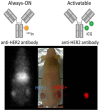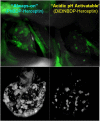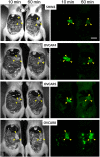Fluorescence-Guided Surgery
- PMID: 29312886
- PMCID: PMC5743791
- DOI: 10.3389/fonc.2017.00314
Fluorescence-Guided Surgery
Abstract
Surgical resection of cancer remains an important treatment modality. Despite advances in preoperative imaging, surgery itself is primarily guided by the surgeon's ability to locate pathology with conventional white light imaging. Fluorescence-guided surgery (FGS) can be used to define tumor location and margins during the procedure. Intraoperative visualization of tumors may not only allow more complete resections but also improve safety by avoiding unnecessary damage to normal tissue which can also reduce operative time and decrease the need for second-look surgeries. A number of new FGS imaging probes have recently been developed, complementing a small but useful number of existing probes. In this review, we describe current and new fluorescent probes that may assist FGS.
Keywords: activatable probe; always-on probe; fluorescence-guided surgery; molecular imaging; monoclonal antibodies.
Figures




References
Publication types
Grants and funding
LinkOut - more resources
Full Text Sources
Other Literature Sources

